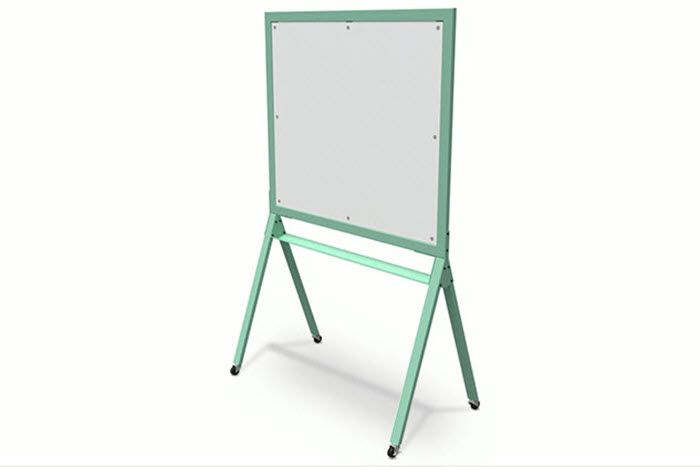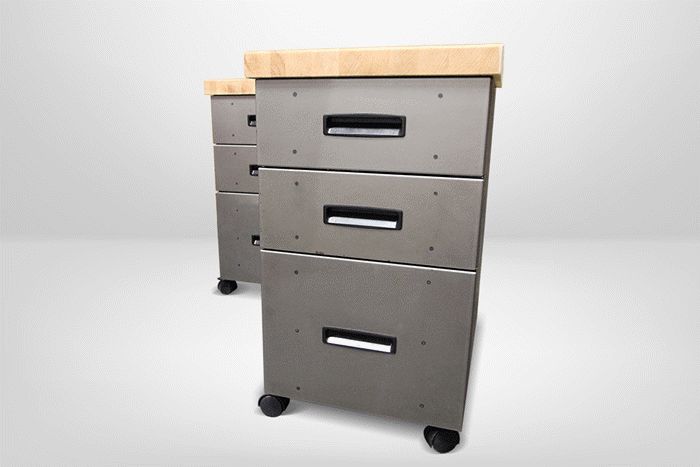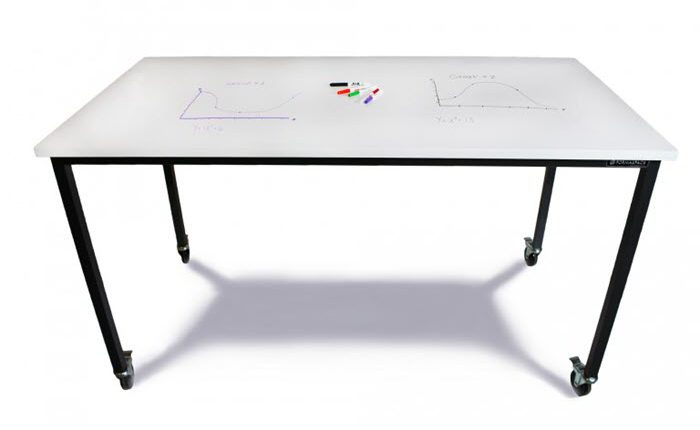As more and more Millennials enter the workplace, they are gravitating toward corporate campus work environments that mimic the best features of college campus facilities, ranging from informal collaboration spaces for group projects to light-filled libraries that offer quiet places to study. Companies who are actively competing to recruit Millennial workers are acting on this trend by introducing campus-style offices with open office designs that not only feel familiar to recent college graduates but are also appealing to more seasoned workers.
First, a little context before we talk about how college campuses are changing the way we design corporate campus-style offices to attract Millennial workers.
Did you know that Millennials are the highest educated generation to date? In 2016, Pew Research found that 40% of Millennial workers between 25 and 29 had a bachelor’s degree or higher.
This high level of education makes Millennials a coveted target for companies that are vying to recruit new talent— especially those companies in the tech sector that are feeling the pinch from an ongoing shortage of knowledge workers.
Competition for hiring Millennial tech graduates is especially fierce. But savvy companies have uncovered a secret competitive advantage: many Millennial job candidates are highly influenced by the way their prospective office space looks.

NCR is a good example of a company that’s acting on this insight, says Corey Hutchins, Formaspace National Sales Manager. NCR moved their national headquarters to Atlanta to “be right across the highway from Georgia Tech, where they can attract some of the best engineers in the country. And they want the absolute best furniture — much of it custom — to encourage graduating engineers to move across the highway and start their careers at NCR’s new HQ.”
In the minds of today’s Millennial job candidates, isolated desks situated in cold, impersonal cube farms are a definite ‘rule out.’ Instead, the more a corporate campus looks like a college campus, the better.
But which elements of college campus design are the most important to them? To find out, we take a look at a day in the life of today’s typical college student.
What Does a Day in the Life of College Student on Campus Look Like?
In the eyes of the Baby Boomer generation, life on campus for the Millennial generation looks pretty sweet.
Went to the library too late to check out a book? No problem, all the research databases and journals are accessible from your smart-phone, tablet or PC — available 24 x 7. You can also forget about collecting class notes and hard copy handouts, these are now online. You can also submit your homework over the internet as well.
The college campus offers many choices for where to work. Wi-Fi is available all across campus so you can study inside or outside, from the dorm room to the quiet carrels in the library, to the outside patio at the coffeehouse on the central square. When it’s time to work on team projects, there are also quite a few options, from casual seating in the student center to reservable conference rooms in the library, to project group workbenches and worktables in student labs.
Perhaps the only things that haven’t changed are study breaks. Still, not too much studying goes on at these, so nothing new there.
8 Things College Campuses Can Teach the Corporate Office Environment
Given the flexible learning environments found on college campuses, is it any wonder that today’s young Millennial new hires suffer from culture shock when contemplating the prospect of working in a traditional office — at an assigned desk with no window — for 8 hours a day, 5 days a week, 50 weeks a year?
It’s for this reason that so many of the most sought-after Millennial college graduates prefer to accept job offers from companies that have college campus-style offices that are based on open office design principles. These companies simply feel like an extension of the college life they have experienced over the past four or more years.
So, given this premise, let’s take a look in detail at eight specific design elements that remind Millennials of their coming-of-age college campus experiences and how these design principles can be replicated on corporate campuses.
1. The Freedom to Work Anywhere on Campus
Thanks to pervasive Wi-Fi available across campus, our Millennial college student is accustomed to working anywhere, from open areas outdoors, to quiet spaces tucked inside the library — and everywhere in between.
They are entirely comfortable using technology as well. As the first truly Digital Native generation, Millennials have the highest penetration of smartphone ownership — at 92% per Pew Research. (Unsurprisingly, Millennials are also the biggest adopters of social media, at 85%.)
Design Insight: Corporate campus-style offices (and their IT departments) should embrace the freedom to work anywhere on campus using mobile devices to access work information.
2. Natural Light and Outside Views Brighten the Work Day Mood
Over the past 25 years, college and university campuses have been replacing (or extensively remodeling) education buildings that have reached their end of life. Instead of small, enclosed classrooms with drop ceilings kitted out with harsh fluorescent lighting, today’s modern educational facilities typically feature wide open spaces that offer ample natural light and outside views. This is good news, for natural light helps improve our mental health. It’s also a highly requested amenity according to recent surveys from Oxford Economics as well as our own Formaspace Work Life Awareness Survey.
Design Insight: Corporate campus-style offices should take a cue from the latest college campus building designs which feature ample natural light and outside views.
3. Refresh and Recharge by Working Outdoors
As we saw in our day-in-the-life scenario, college students also take advantage of working in the great outdoors. Many college campuses support this by boosting Wi-Fi signals to reach shady outdoor seating areas adjacent to campus cafeterias, coffee shops, and park facilities. This is part of the greater trend toward biophilic design, which seeks to connect us with the natural world outside, even when we are working.
Design Insight: Expand corporate cafeterias to include outside seating areas (with Wi-Fi and shade) so employees can work outdoors in the fresh air throughout the day.
4. Move Between Different Work ‘Neighborhoods’ Throughout the Day
Our Millennial college student is comfortable changing up work locations and seating positions throughout the day, moving from a communal table in the coffeehouse in the morning, to a quiet semi-private carrel desk in the library, to a mid-day team project meeting across a science lab workbench, to a comfortable lounge chair in the student center during the afternoon.
Design Insight: Corporate campus-style offices can emulate these varied college campus environments by creating their own network of “work neighborhoods” on corporate campuses. To encourage employees to be more active yet comfortable at work, you should also specify ergonomic, height-adjustable desks. (These “Sit-to-Stand” desks are also ideal for accommodating employees of different sizes.)
5. Work Together in Dedicated Collaboration Spaces
College campuses also offer a wide variety of collaboration spaces where students can work on team projects*, from library conference rooms to lab workbenches, to informal areas in a student lounge, or at tables placed outside a campus coffee shop or cafeteria.
*FYI in college parlance, “team” projects are assigned to specific individuals who will work together. On the other hand, “group” projects refer to an assignment given to any number of students, who may or may not choose to work together.
Design Insight: Corporate campus-style offices are picking up on this trend by providing project collaboration spaces in the form of enhanced cafeterias, project-oriented conference rooms, and their smaller variant, huddle rooms, which are kitted out with communication technology to support project collaboration. Many new offices (see an outstanding example below) are doing away with assigned desks altogether. Instead, relying on ‘hot desking,’ which provides reserved access to workspaces based on an employee’s current assignment or work style.
Deloitte’s new consulting office in The Netherlands uses a custom high-tech app to provide each employee with workspace options that are updated daily based on their current project assignments.
6. Serendipity at Work: Make the Most of Face-to-Face Encounters
One of the great benefits of being on a college campus is the increased chance of running into professors and other students who share a common interest. These spontaneous, serendipitous encounters can often lead to future academic opportunities and other valuable future connections.
In corporate terms, chance encounters can be responsible for making important connections, while helping break down the “silo” effect, where one department doesn’t know what the other is doing.
Design Insight: Make the most of spontaneous face-to-face encounters by providing easy access to casual collaboration zones — kitted out with comfortable, casual seating and useful collaboration tools, such as mobile dry erase market panels for impromptu brainstorming sessions.
- Mobile whiteboard
- Mobile pedestal
- Dry erase top table
7. Get into the Zone: Find Your Quiet Space to Work
Given the variety of built environments on university campuses, college students often have wide a choice of quiet places to read, study, and work — ranging from private dorm rooms to quiet zones in the library, to uncrowded outside areas.

Recreating these types of quiet work environments within corporate campus-style offices is an ongoing challenge. As Interior Designer, Gracie Conner, of Sixthriver Architects, noted during our recent interview on the rise of custom furniture, “In corporate design, there is a push for open concept, which is great, but this does come with its challenges, because there is now an emerging trend to create little private spaces within the bigger open spaces.”
Design Insight: According to the Oxford Economics workplace study mentioned earlier, corporate employees working in an open office design rank having a quiet place to work when it’s time to concentrate on a project as a top amenity (outranking other perks, such as free meals at the office or on-site daycare). This finding was also confirmed in our new Formaspace Work Life Awareness Survey.
TIP: Be sure to also check out our guide to reducing noise in your workplace.
8. Makerspaces: The Key to In-House Product Innovation
More and more colleges and universities are investing in Makerspaces to provide students with hands-on learning experiences that help reinforce principles learned as part of STEM classes in science, technology, engineering, and math.
Companies that produce physical products can benefit from providing their employees with access to Makerspaces on corporate campuses as well. The ability to print out a design using a 3D printer within the office — or assembling a working model of a product using an Arduino or Raspberry processor and sensors — can speed up the design process. It’s also more secure than sending work out to external prototyping vendors.
Design Recommendation: Talk to your Formaspace Design Consultant for tips on how to design the layout, storage, and working areas of a Makerspace on your corporate campus.
Employees working at Pinterest can show off their own personal arts and crafts “collections” in the Pinterest employee art gallery and lounge.
Don’t know How to Get Started? Formaspace Can Help.
You can depend on Formaspace to deliver office productivity solutions.
If you are struggling with the beginning stages of creating an office layout, check out our article on the seven things you need to know to create a productive office design.
Not sure how much space to allocate for each employee in open office design? Refer to our guide to open office planning. It also explains how to use our online office space calculator tool.
When it’s time to start populating your office space with desks and tables, why not check out our new Virtual Furniture Designer? It allows you to modify our standard product lines to your liking by choosing different top surface materials, frame colors, and finishes, as well as storage, lighting, and other convenience features.
If you can imagine it, we can build it. We also offer custom furniture solutions as well as fully one-of-a-kind bespoke options, built to your design specification at our American factory headquarters in Austin, Texas. And it’s backed by our no-questions-asked 12-year guarantee.
To be honest, there’s even more that we can offer you. To find out more, contact your friendly Formaspace Design Consultant.
You’ll learn why famous companies, such as SpaceX, Oculus, Toyota, Busch, Apple, Google, Twitter, Capital One, and Parabola choose our furniture products.



